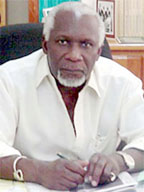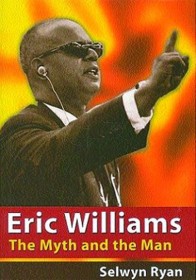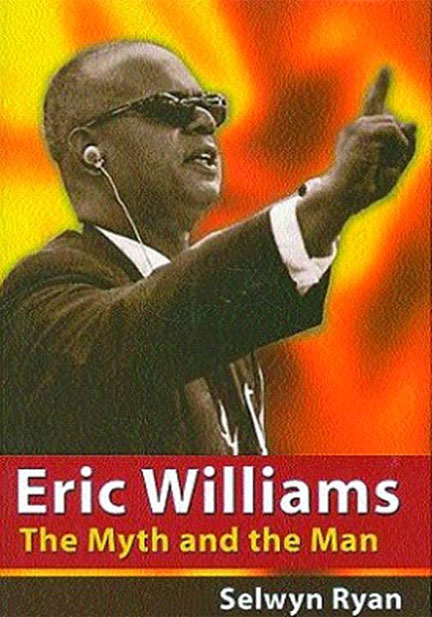Selwyn Ryan
Eric Williams: The Myth and the Man
(Mona: UWI Press, 842 pp)
Selwyn Ryan states what was clearly his primary purpose in writing the massive and monumental biography Eric Williams: The Myth and the Man: “One of the aims of this study was to go behind the mask and the tribal myths to try to answer the perennial question, who was “the real Eric Williams”? (760). A few pages later, he rationalizes the approach he adopted: “Greek tragedy may serve to provide emplotment for the Williams legend, but such an exercise befits a dramatic poet and not a historian or a social scientist” (766).

Any responsible evaluation of Ryan’s work must take into account his stated aim and his approach of choice. Going behind the mask and the tribal myths involves a 40-year quest as Ryan himself testifies (1-3). This quest takes the form of a careful scrutiny of almost everything that has ever been written by and about Williams and about the period 1956-1981. This material ranges from published histories and conference papers, official documents and public addresses, biographies and autobiographies, private letters and diaries, monographs and essays including calypso histories and commentaries. It also includes published and unpublished interviews conducted with people with access to Williams. Ryan carefully interrogates his sources and presents logical reasoned conclusions on the material available. The result of this Herculean endeavour is a balanced account of Williams.
Seven hundred and eighty five pages of commentary and critique, analysis and assessment lead organically to the conclusion, “And so, Williams was not Plato’s mythical, unblemished philosopher king. He was challenged in many ways. On balance, however, his performance was worthy of history’s applause” (786). Ryan’s study, too, can be assessed as worthy of history’s applause.
A very revealing paragraph reveals as much about its author as it does about its subject: The focus here is on the public as opposed to the private Williams. My principal concern is with Williams as scholar, builder of the nation-state of Trinidad and Tobago, shaper of public policy, and political man. Yet a biographer could not avoid dealing with the personality issue and the various contested claims that Williams was psychiatrically challenged and that his presumed illness is the key to understanding his curious and contradictory and strange behavior, as well as some of the policy and personnel decisions he made. Regretfully one could not be faithful to the record without also dealing with the many allegations about sleaze that dogged Williams’s regime and that he seemed unwilling or unable to address successfully (4).

As intended by the author, a clear picture of the public Williams emerges from the biography but it is impossible to define and describe this public self without engaging the private personality. Ryan does this regretfully but without malice, explaining:
In this study of Williams, I have tried to follow Plutarch in his search for balance. I have focused on the good, the bad and the very bad, and have found that Williams was not always the hero that the constructed myths made him out to be. Neither was he the wicked genius that some saw and some still see him to be. The truth abut him lies in the middle, as readers shall discover. Williams was capable of great human warmth as well as rudeness and insensitivity. That and much else, remains puzzling (6).
This last statement puzzles me somewhat because the contradictions in the Williams personality mean simply that he was human. He was, as the biography confirms, a special man of extraordinary talents but a man who achieved greatness, Caribbean style, at the cost of the erosion of his humanity. He was a dangerous man to cross and elevation to eminence at his hands was nearly always a prelude to a precipitous fall from grace. And yet the biography cites documents which testify to his being wracked by demons of doubt and insecurity. What is more puzzling is Ryan’s attempt to deconstruct and dismantle the myth while sparing the man. Quite clinical in analyzing Williams as scholar, as political personality and so on, Ryan seems reluctant to inhale the stench of sleaze which emanates from certain transactions involving John O’Halloran, an individual whose proximity to Williams can only be explained in terms of human need. Ryan’s reluctance to penetrate this area of darkness may well be a function of training and upbringing in that scholars, particularly of the British school, are reluctant to invade the privacy of their subjects. It may also be a professional caution against entering the minefield of rumor and speculation.
Whatever the reasons, Ryan’s reticence inadvertently cultivates the Williams myth; worse, Ryan’s treatment of the entire issue can only invite further unwelcomed speculation. Representing John O’Halloran as a Rasputin instead of a calculating Falstaff, ennobles O’Halloran and mystifies the relationship between this colorful gregarious personality and the man who is mythically represented as an elusive, reclusive scholar-politician.
Although the content of the study is compelling, Ryan’s narratological choices are more intriguing. He set himself the daunting task of shaping into biography the political history of Trinidad and Tobago 1956-81, which is what Williams personified, and although he eschews the emplotment strategies of Greek tragedy, he knits the chapters into a whole by a consistent psychological profiling, a consistent attempt to understand the psychological motivations for Williams’s actions. Ryan examines incident after incident analyzing each in turn and arrives at the ineluctable conclusion that Williams, in addition to being the victim of a wounded psyche, as Deosaran argued in 1981, increasingly became the victim of a bipolar disorder.
When Ryan engages the mass of material from 1956-1981, the political scientist trumps the biographer. The psephologist in him thinks it necessary to provide detailed information about each of the five general elections contested by Williams. Readers need to have some idea of who and what Williams was up against in each general election and how he triumphed, but we could have been referred to the appropriate sections of Race and Nationalism and Revolution and Reaction for the details of the campaigns including the whining of losers and so on. One benefit of this approach would be the justifiable exclusion of those bit-role characters who deserve no mention in a biography of a legend.
Minimizing circumstantial detail of this kind would also result in a more precise focus on the major moments of Williams’s life and career and this focus would have made for a more compelling and persuasive narrative. Williams’s life is presented in detail, for which we are grateful, but I think a more dramatic narrative effect, not necessarily the electric excitement of the best Greek tragedy, would have been achieved if, after the necessarily detailed expose of the early years, Ryan focused on the major moments of public life like Williams’s resignation from the Anglo-American Commission, the formation of the PNM, the road to Chaguaramas, and the story of 1970. The period 1973 to 1981 impresses me (no dramatist myself) as being a period of tremendous dramatic potential. The descent from the surreality of Williams’s last days to the banality of the 1981 general elections is anti-climactic. The mystery of his passing seems like the best place to end the account paving the way for the grand conclusions about the Williams personality.
Eric Williams: The Myth and the Man is a welcome addition to the growing body of scholarly literature on Trinidad and Tobago. It must be useful in specialized academic disciplines like history and political anthropology. More than that, it should be recommended reading to every citizen of Trinidad and Tobago, and especially those who now pronounce and pontificate on public affairs in blissful Trini ignorance of what Bro Valentino in “De Roaring Seventies” (1984) calls “the history that went on down here.”
Reprinted from Trinidad and Tobago Review website






